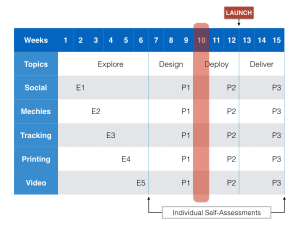 This week — our first week back after Spring Break — marked the first of three weeks in the “Deploy” phase of the class. We are launching in less than a month — Saturday, April 2, @ 10:00 — weather permitting! We therefore spent this week working on several big picture action items: 1) preparing to assemble the payload; 2) developing a testing plan for the mechanics and electronics; and 3) developing a pre-launch checklist for the day of the launch.
This week — our first week back after Spring Break — marked the first of three weeks in the “Deploy” phase of the class. We are launching in less than a month — Saturday, April 2, @ 10:00 — weather permitting! We therefore spent this week working on several big picture action items: 1) preparing to assemble the payload; 2) developing a testing plan for the mechanics and electronics; and 3) developing a pre-launch checklist for the day of the launch.
Our goal as we head towards the Launch Day is to make sure we don’t go into any of this blind — we need a clear checklist of everything that needs to be ready before we let the balloon go: batteries charged, trackers transmitting, cameras running, etc. We need to be 100% sure (as best as possible) that nothing unexpected will happen. To that end, each Team worked on the following items this week:
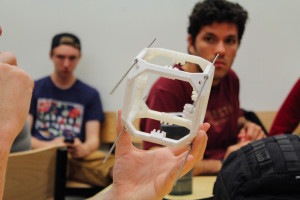 Team Video printed and tested the strength / stability of the final version of their 3D-printed mount for the 360 degree video cameras. They also tested installing the cameras in the mounts, and checked to see how far in front of the cameras the 3D-printed copy of the FSU torches should be placed. Finally, they prepared for the 360 degree video, making sure that all the cameras were ready, including batteries and storage media.
Team Video printed and tested the strength / stability of the final version of their 3D-printed mount for the 360 degree video cameras. They also tested installing the cameras in the mounts, and checked to see how far in front of the cameras the 3D-printed copy of the FSU torches should be placed. Finally, they prepared for the 360 degree video, making sure that all the cameras were ready, including batteries and storage media.
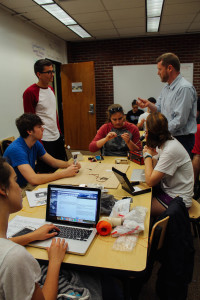 Team Printing finalized their design of the FSU Torches, printed their design, and tested attaching the torches to the payload. They also explored the potential use of a protective coating for the 3D printed material, in order to increase the stability of both the torches and the camera rig.
Team Printing finalized their design of the FSU Torches, printed their design, and tested attaching the torches to the payload. They also explored the potential use of a protective coating for the 3D printed material, in order to increase the stability of both the torches and the camera rig.
Team Tracking worked on learning how the new Flight Computer and APRS Radio Transmitter worked, in preparation for meeting with the Tallahassee Amateur Radio Society during Week 11. They also worked on solving the problems with the cellular GPS tracker, eventually deciding that it may not work for our trip into space. Between the SPOT satellite tracking system and the APRS Radio Bug, though, we should be in good shape.
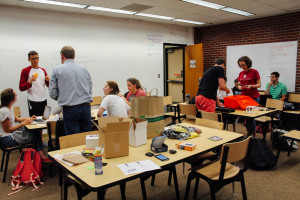 Team Mechies laid out entire payload, including all the electronics on top, and the camera rig underneath, and marked the plywood platform so that we know where everything will go. They drilled holes, installed bolts, and tested the twine by dangling the payload from the parachute, making sure it will not snap in flight. They worked with the Team Video and Team Printing to make sure everything was ready to be assembled next week.
Team Mechies laid out entire payload, including all the electronics on top, and the camera rig underneath, and marked the plywood platform so that we know where everything will go. They drilled holes, installed bolts, and tested the twine by dangling the payload from the parachute, making sure it will not snap in flight. They worked with the Team Video and Team Printing to make sure everything was ready to be assembled next week.
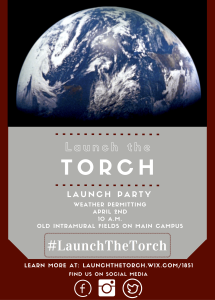 Team Social documented all the in-class activities on social media, and prepared to roll out their social media campaign leading up to the April 2 launch date. They also prepared flyers / handouts to advertise the Launch at Digitech 2016, including a poster for the iSchool’s display table. We also created a Facebook event page to help spread the word and encourage people to attend the Launch.
Team Social documented all the in-class activities on social media, and prepared to roll out their social media campaign leading up to the April 2 launch date. They also prepared flyers / handouts to advertise the Launch at Digitech 2016, including a poster for the iSchool’s display table. We also created a Facebook event page to help spread the word and encourage people to attend the Launch.